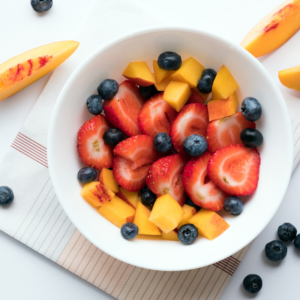Eating to Prevent Diabetes
 Did you know that people who consume more fruits, vegetables, and whole grains have a lower risk of developing type 2 diabetes? A recent study found that eating ample fruits or vegetables can lower your risk of developing diabetes by 25%.
Did you know that people who consume more fruits, vegetables, and whole grains have a lower risk of developing type 2 diabetes? A recent study found that eating ample fruits or vegetables can lower your risk of developing diabetes by 25%.
Fruits, vegetables and whole grains are not only delicious, they are power-packed with important nutrients. You’ll find fiber, vitamin C, vitamin K, potassium, magnesium, and many more vitamins in minerals in fruits and vegetables, as well as dietary fiber, B vitamins, iron, zinc, copper, and magnesium in whole grains! Incorporating fruits, vegetables and whole grains into your diet doesn’t have to be a struggle, there are so many ways to ensure you are consuming enough of these power foods.
4 Ways to Include Fruits and Veggies in Your Eating Plan:
Eating the recommended daily serving of fruits and vegetables is not always easy. However, there are little tips you can try to increase your intake and enhance your meals. Here are some of my favorite ways to include fruits and veggies into my day:
- Smoothies are a great way to pack in different fruits and veggies into a single serving. There are many different combinations you can experiment with by using different foods. You can get even more creative by making a delicious smoothie bowl and top things off with coconut flakes, chopped nuts, raisins, or sliced bananas.
- Snack on cut-up veggies or dried fruits. Carrot or celery sticks with hummus is a great pairing or you could try some homemade trail mix. Carry these snacks around with you so when you feel hungry you can fuel your body with these nourishing foods.
- Fill half your plate with veggies at lunch or dinner time. The internet has plenty of recipes you can try out that focus on veggies. They can be part of your sandwich, a soup, a casserole, tacos, pasta, or many other things.
- Add in some fruit to your breakfast cereal or enjoy them for a dessert. They can sweeten any dish in an instant.
4 Whole Grains to Try:
Whole grains are so powerful that consuming just one serving or more a day such as a morning oatmeal or a sandwich on whole grain read could lower your of developing diabetes. Here are some ways to add whole grains to your diet:
- Oatmeal is a great source of a soluble fiber called beta-glucan. This fiber can help to lower cholesterol and LDL levels, lower blood sugar and improve insulin response, feed your good gut bacteria, and keep you feeling full.
- Brown rice is a high fiber alternative to white rice, and can help promote proper digestion while also lowering your cholesterol levels.
- Quinoa is a protein-rich whole grain. It also contains lots of fiber, iron, magnesium, riboflavin, and manganese. Together these nutrients help manage blood sugar, protect the body’s cells against damage, and regulate metabolism.
- Barley contains beta-glucans just like oatmeal does and as a result, can help lower blood sugar levels. Barley is rich in other nutrients too like manganese, selenium, copper, vitamin B1, chromium, phosphorus, magnesium, and niacin.
Diabetes prevention is important, but so is diabetes management for those who already have diabetes. The key is a weight-neutral approach with lifestyle practices that work for YOU.
If you’d like to learn more about managing your diabetes without focusing on the scale, check out my Healthy Living with Diabetes Program™ which focuses on nutrition, movement, habits, behaviors, stress management, and sleep hygiene. Find out more HERE.
Your Turn to Take Action: How do you ensure you are eating your fruits, veggies and whole grains each day?


Leave a Reply
Want to join the discussion?Feel free to contribute!